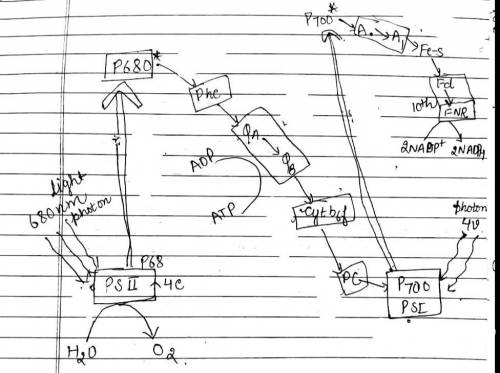
The following 9 steps in the linear (or noncyclic) electron flow of the light reactions in photosynthesis are in random order. Indicate the correct chronological order.
(Please note, do not rely on the step numbers providied in your textbook. The order is the same, but some steps below may be combined or split relative to how the textbook numbers the steps.)
Oxygen is formed as an endproduct. Answer836142579
An electron is transfered from an electron transport chain from photosystem II to photosystem I's primary electron acceptor. Answer328547691
NADP+ is reduced to NADPH. Answer167483259
An electron is transferred from photosystem II to the primary electron acceptor. Answer284175396
Electrons are passed from photosystem I through an electron transport chain. Answer312487569
A photon of light excites photosystem II. Answer846925731
ATP is synthesized as the electrons pass through an electron transport chain to photosystem I. Answer861243597
A water molecule is split, the electrons are transferred to photosystem II. Answer578143269
A photon of light strikes photosystem I, an excited electron is transferred to the primary electron acceptor.

Answers: 3
Another question on Biology

Biology, 21.06.2019 16:00
You need to make 500ml of 7h9(+) media with 1x adn and 30ug/ml of the antibiotic kanamycin. your stock solutions are 10x adn and 30mg/ml of kanamycin. the solvent is distilled water. how much of each component will you need to make the desired final solution?
Answers: 2

Biology, 22.06.2019 02:00
Many farmers prefer cattle without horns because it is safer for their herds. the allele for no horns (n) is dominant to the allele for the presence of horns (n). a farmer mates a male with horns to a heterozygous female without horns. what is the chance that the offspring will have horns?
Answers: 1

Biology, 22.06.2019 11:30
What is the process by which biological parents pass traits such as hair type or eye color to their children
Answers: 1

Biology, 22.06.2019 15:00
How do temperature and salinity affect deepwater currents? they create changes in wind direction, moving denser water in the same direction as the wind and causing the deepwater circulation patterns found in the ocean. as temperatures and salinity levels of water increase, the water rises to the surface where it creates currents as it moves to colder regions. they create density differences that cause dense deepwater currents to flow toward the equator where they displace less dense, warmer water above them. they equalize the forces on undersea currents caused by the coriolis effect as they replace more dense water with less dense water.
Answers: 1
You know the right answer?
The following 9 steps in the linear (or noncyclic) electron flow of the light reactions in photosynt...
Questions




English, 25.06.2019 12:30

Mathematics, 25.06.2019 12:30

Mathematics, 25.06.2019 12:30


Physics, 25.06.2019 12:30


History, 25.06.2019 12:30

Social Studies, 25.06.2019 12:30

English, 25.06.2019 12:30







Geography, 25.06.2019 12:30




